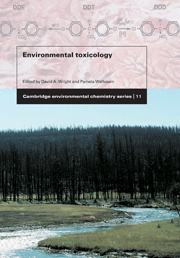Book contents
- Frontmatter
- Contents
- Foreword
- Preface
- Abbreviations
- Acknowledgements
- 1 The emergence of environmental toxicology as science
- 2 The science of environmental toxicology: Concepts and definitions
- 3 Routes and kinetics of toxicant uptake
- 4 Methodological approaches
- 5 Factors affecting toxicity
- 6 Metals and other inorganic chemicals
- 7 Organic compounds
- 8 Ionising radiation
- 9 Complex issues
- 10 Risk assessment
- 11 Recovery, rehabilitation, and reclamation
- 12 Regulatory toxicology
- 13 An overall perspective, or where to from here?
- Glossary
- Index
4 - Methodological approaches
Published online by Cambridge University Press: 05 June 2012
- Frontmatter
- Contents
- Foreword
- Preface
- Abbreviations
- Acknowledgements
- 1 The emergence of environmental toxicology as science
- 2 The science of environmental toxicology: Concepts and definitions
- 3 Routes and kinetics of toxicant uptake
- 4 Methodological approaches
- 5 Factors affecting toxicity
- 6 Metals and other inorganic chemicals
- 7 Organic compounds
- 8 Ionising radiation
- 9 Complex issues
- 10 Risk assessment
- 11 Recovery, rehabilitation, and reclamation
- 12 Regulatory toxicology
- 13 An overall perspective, or where to from here?
- Glossary
- Index
Summary
Introduction
In Chapter 2, attention was drawn to some of the distinctions between classical toxicology and environmental or ecotoxicology, as well as to the fact that the two types of toxicology share considerable common ground. For example, concepts such as acute and chronic toxicity and thresholds, which were developed for classical toxicology, have been applied to environmental toxicology (see Sections 2.2.2, 2.2.3, and 2.2.4). Classical toxicology has relied mainly on evidence from controlled exposure of individual organisms or from epidemiological approaches including retrospective case studies, and more recently it has seen the development of more generic tests on cell lines and microorganisms. Environmental toxicology includes comparable types of testing but by its very nature has to go beyond the responses of individual organisms or populations.
The development of methods for determining the impact of man on the environment has advanced on several different fronts. The term ecotoxicology, first used by Truhaut as recently as 1969 (see Chapter 1), encompasses the study of all levels of biological organisation described in Figure 2.1. At lower levels of biological organisation (subcellular to individual), the approaches used have much in common with human toxicology. Indeed, the distinction between the two disciplines may be somewhat arbitrary, particularly because so many aspects of environmental toxicology have implications for human health. A clearer distinction between the two disciplines is seen in studies at the population and community levels where methods for determining the impact of man on ecosystems have matured in parallel with a better understanding of ecology.
Information
- Type
- Chapter
- Information
- Environmental Toxicology , pp. 97 - 217Publisher: Cambridge University PressPrint publication year: 2002
